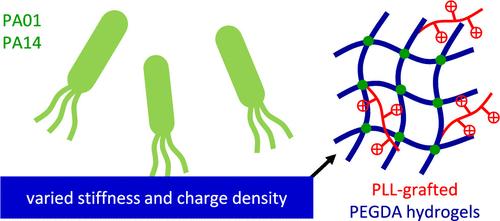铜绿假单胞菌在聚赖氨酸系链水凝胶上的粘附和生物膜形成:底物硬度和正电荷密度的协同效应
IF 3.9
2区 化学
Q2 CHEMISTRY, MULTIDISCIPLINARY
引用次数: 0
摘要
与耐药铜绿假单胞菌(P. aeruginosa)相关的感染是患者发病和死亡的主要原因,是社区获得性和医院感染治疗的最大挑战之一。为了开发抗菌水凝胶涂层来控制P. aeruginosa的粘附和随后的生物膜形成,我们使用了具有不同交联密度的光交联聚(乙二醇)二丙烯酸酯(PEGDA)水凝胶和不同重量组成的共价接枝聚(l-赖氨酸)(PLL)。研究了水凝胶的表面刚度和正电荷密度对铜绿假单胞菌PA01和PA14两种主要菌株的影响。我们发现附着细胞的数量和活力与水凝胶硬度呈正相关,导致在较硬的基质上播种72 h时细胞集落更厚,覆盖面积更大。PA01和PA14菌株对大肠杆菌的依赖性均为非单调的。接枝的PLL链中游离胺基的正电荷显著促进了两种菌株在低浓度浓度下的初始粘附和增殖,并在接枝浓度为1-2%的最硬水凝胶上形成最厚的生物膜。然而,在最软的水凝胶上接枝的PLL,在7-10%的高PLL下,细菌不再附着或存活。这些结果不仅提高了我们对细菌-材料相互作用的基本认识,而且提供了一系列具有可控刚度和正电荷密度的pll接枝PEGDA水凝胶作为理想的表面涂层材料,以防止细菌感染。本文章由计算机程序翻译,如有差异,请以英文原文为准。

Pseudomonas aeruginosa Adhesion and Biofilm Formation on Poly(l-lysine)-Tethered Hydrogels: Synergistic Effect of Substrate Stiffness and Positive Charge Density
Infections associated with antibacterial-resistant Pseudomonas aeruginosa (P. aeruginosa) are the major cause of morbidity and mortality of patients, presenting one of the greatest therapeutic challenges for treatment of community-acquired and nosocomial infections. To develop antimicrobial hydrogel coatings to control the adhesion and subsequent biofilm formation of P. aeruginosa, we have used photo-cross-linked poly(ethylene glycol) diacrylate (PEGDA) hydrogels with varied cross-linking densities and covalently grafted poly(l-lysine) (PLL) at different weight compositions (ϕPLL). Both surface stiffness and positive charge density of the hydrogels were efficiently tuned over a broad range to investigate their effects on two main strains of P. aeruginosa, PA01 and PA14. We found that both number and viability of attached cells were positively correlated with the hydrogel stiffness, leading to thicker and larger coverage of cell colonies at 72 h postseeding on the stiffer substrates. The dependence of both PA01 and PA14 strains on ϕPLL, however, was nonmonotonic. Positive charges from dissociated amine groups in the grafted PLL chains significantly promoted initial adhesion and proliferation of both strains at low ϕPLL and developed into the thickest biofilms on the stiffest hydrogels grafted with ϕPLL of 1–2%. Nevertheless, on the softest hydrogels grafted with PLL at high ϕPLL of 7–10%, the bacteria no longer attached or survived. These results not only improved our fundamental understanding of bacteria-material interactions but also provided a series of PLL-grafted PEGDA hydrogels with controlled stiffness and positive charge density as ideal surface coating materials to prevent bacterial infections.
求助全文
通过发布文献求助,成功后即可免费获取论文全文。
去求助
来源期刊

Langmuir
化学-材料科学:综合
CiteScore
6.50
自引率
10.30%
发文量
1464
审稿时长
2.1 months
期刊介绍:
Langmuir is an interdisciplinary journal publishing articles in the following subject categories:
Colloids: surfactants and self-assembly, dispersions, emulsions, foams
Interfaces: adsorption, reactions, films, forces
Biological Interfaces: biocolloids, biomolecular and biomimetic materials
Materials: nano- and mesostructured materials, polymers, gels, liquid crystals
Electrochemistry: interfacial charge transfer, charge transport, electrocatalysis, electrokinetic phenomena, bioelectrochemistry
Devices and Applications: sensors, fluidics, patterning, catalysis, photonic crystals
However, when high-impact, original work is submitted that does not fit within the above categories, decisions to accept or decline such papers will be based on one criteria: What Would Irving Do?
Langmuir ranks #2 in citations out of 136 journals in the category of Physical Chemistry with 113,157 total citations. The journal received an Impact Factor of 4.384*.
This journal is also indexed in the categories of Materials Science (ranked #1) and Multidisciplinary Chemistry (ranked #5).
 求助内容:
求助内容: 应助结果提醒方式:
应助结果提醒方式:


